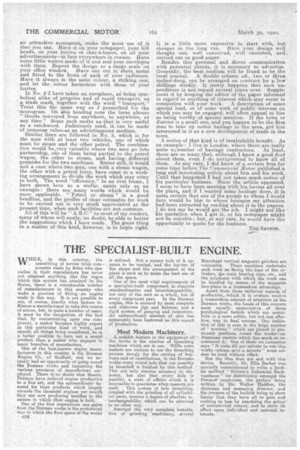THE SPECIALIST-BUILT ENGINE.
Page 22

If you've noticed an error in this article please click here to report it so we can fix it.
UTILE, in this country, the V1/ . assembling of lorries from corn
ponents made by firms who specialize in their manufacture has never yet attained anything like the vogue which this system has attained in the States, there is a considerable number of manufacturers in this country who make a practice of fitting an engine made in this way. It is not possible to say, of course, exactly. what factors influence a manufacturer to take this course of action, but, in quite a. number of cases, it must be the recognition of the fact that, by concentrating upon one component, a maker-becomes highly expert at this particular kind of work, and should, all things being considered, be in a better position to. turn out a sound product than a maker who engages in many branches of manufacture.
One of the best-known engine manufacturers in this country is the Dorman Engine Co., of Stafford, and we re"cently had an opportunity of going round the Dorman works and inspecting the various processes of manufacture employed. There is no doubt that Messrs. Dorman have reduced engine production to a fine art, and the extraordinary demand for their products which largely exceeds'the thousa.rd engines per month they are now producing testifies to the esteem in which their engine is held. One of the first impressions one ga5ris from the Dorman works is the economical -way in Which the floor space of th.0 -works c32 is utihzed. Not a square inch of it appears to be wasted, and the lay-cmt, of the shops and the arrangement of the plant is such as to make the best use of all the space.
One of the most vital -requirements of a specialist-built component is absolute standardization and Interchangeability, not only of the unit as a whole, hut of every component part, In the Dorman engine this is ensured by moat complete and elaborate jigs and fixtures, and a rigid system of gauging and inspection. An extraordinary amount of care had apparently been 'bestowed on this aspect of production.
Most Modern Machinery.
-A notable feature in the equipment of / the works is the number of broaching machines which are in -use. Whlle some makers are content to use the broaching process mere,ly for the cuttinaof key., ways and of castellations, in the Dorman works every round hole that can possibly be broachell is finished by this method. This not only ensures accuracy in diameter, but also that every hole 'is parallel, a state of affairs which it is impossible to guarantee when reamers Are used. This system of hole broaching, coupled with the grinding of all cylindrical parts, ensures a degree of absolute interchangeability which can be obtained in no other way.
Amongst the very complete installationof . grinding machinery, several
Blanchancl vertical magnetic grinders are noticeable. TheSe machines undertake such work as facing the tops of the cylinders, tile main bearing caps, etc., and the quickness with which the work can be handled by means of the magnetic face-plate is a tremendous advantage.
Apart from these technical aspects' of production, "Which it is evident receivea tremendous amount of attention at the Dorman works, the heads of this concern seem equally appreciative of those psychological factors which can contribute in a more subtle, but not, less effeetive, way to final success. One indication of this is seen in the large n-umber of 'mottoes" which are placed in prominent positions round the works—an American custom which has much to recommend it. • One of these we remember says "It-costs £2 per minute to run this works .please save a minute" must seldom be read without effect.
But the idea. does not end with this device. Recently, Mr. Ellis Barker was specially commissioned to write a booklet; entitled "Britain's Industrial. Backwardness" for distribution amongst the Dorman employees, the preface being written by Mr. Walter Haddon; the chairman and managing director, and the purpose of the booklet being to show labour that they have all to gain and nothing to lose by practising the policy' of unrestricted output. and to show its effect upon individual and national interests.


























